
The full image is 283x383 pixels

During the past couple of years, I have been involved in a cross-cultural choreographic project with Rhapsody in Taps and a Balinese Gamelan from Cal Arts by the name of Burat Wangi. Linda Sohl-Donnell, the artistic director of the company, wanted to create a work utilizing the filigree sounds of a Balinese gamelan to accompany the metallic qualities of tap. She was also interested in capturing the essence of Balinese Dance in our presentation of this work.
How does one interpret a style of dance that is unfamiliar? What does our eye see? Is it the obvious movement, or the small gestural nuance of eyes and head? Nanik became our on-the-spot teacher of movement. She would show us some general movements that were linked together to form �phrases� to counts that we could relate to. But this process was so difficult because of the complexity of the movements involved. The stance is so different. The torso is pitched forward from the pelvis. The legs are bent with a small degree of rotation from the pelvis. The torso, in addition to being pitched forward, is often tilted laterally with the weight sitting in the opposing hip (very uncomfortable). On top of this, there are a multitude of angular arm positions and rotations and flexions of the wrist and fingers. Lets not forget the movements of the head and eyes. This was a lot to digest. It takes years of study for Balinese dancers to accomplish these posturings. There was an urgency in trying to familiarize ourselves with these movements�we had to do this while we were tapping and we were to premier this piece in a few months in Los Angeles. In addition to this, there was a possibility for a few performances in Bali...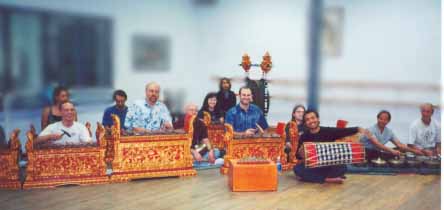 Percussionists whom she had worked with suggested that she get in touch with a gentleman named I Nyoman Wenten, who heads a number of gamelans at universities in the Southern California area. He and his wife, Nanik Wenten, a dancer versed in both Javanese and Balinese styles, became a source for information on our investigation into this multicultural journey.
Percussionists whom she had worked with suggested that she get in touch with a gentleman named I Nyoman Wenten, who heads a number of gamelans at universities in the Southern California area. He and his wife, Nanik Wenten, a dancer versed in both Javanese and Balinese styles, became a source for information on our investigation into this multicultural journey.
Life in Bali exists on a different level. Religion dictates how an individual relates to family, village, and friends. Rituals become a bonding experience for the village...a group effort. This group identity is ever so apparent when you listen to a gamelan. It is a cumulative effort, a layering of different rhythms and distinct textures that make up the whole.
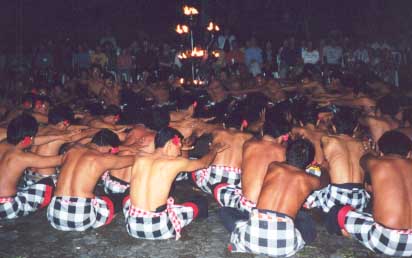
Group rituals are also displayed in dance. The Kecak, or monkey chant originated from a very ancient ritual of Sanghyang (trance) Dance. The male chorus of up to a hundred participants, sit and chant maintaining a syncopated, hypnotic tempo, kecak-kecak-cak.
Previous to our performance, we had attended some Balinese dance performances in Ubud. The Legong dancers were extaordinarly beautiful. Their definitive posturings and subtle flirtations made the dance even more appealing. The precision of their unison dancing was impressive. I immediately started to compare what we were "trying" to accomplish to the "real" thing. I was quite devistated! We also attended the Bali Arts Festival that was occuring in Denpasar. We witnessed two visiting gamelans and their dancers performing. Sitting amongst the Balinese people, we noticed some laughing and what seemed to be snickering remarks from the audience (spoken in their language). Again, the fear of the comparison grabbed me. Was our interpretation of their dance style going to come across successfully, or were we going to thoroughly embarrass ourselves?
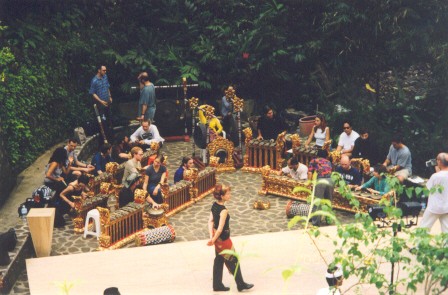
Our first performance was at the Center for World Music, in the village of Payangan. The small but attentive audience consisted of a visiting group from San Diego and a small handful of neighboring villagers and workers from the center. The initial reaction of the villagers was one of surprize. Having never seen tap dance, they had no idea how the sounds were being produced. They were a quiet, appreciative audience.
The stage floor shown above (performance space) was built by hand. Dancer, Bob Carroll, brought a hand powered drill with him, as we were forewarned about the differences in construction methods. Bob was instumental in helping with the design and construction of our floor, which by the way sounded damn-good!
The final performance was in the village of Sading (Wenten's village). The space was a small, open pavilion next to a temple just off the street. As we waited to perform, I noticed a lot of activity occuring in between a small alley that divided the temple from the pavilion. To my surprize, I saw two large groups of men crouching in a circle...they were gambling, having a great time, and were quite oblivious to the gamelan music and Balinese dancing being performed next door.
We were next. Trying to maneuver around the masses of people that encircled the stage area and keep in somewhat "character" to enter for the beginning of the piece proved to be a challenge. Once the dance started, I noticed a moment of quiet from the otherwise chatty audience. But the initial surprize soon wore off, and the buzzing and chattering continued. There was comfort in the knowlege that Wenten had colleagues and friends in the audience that were curious and interested in the collaboration taking place. The general audience did liven up when we did gestures that were specific to Balinese dance and laughed with delight as we performed these movements.
Nusantara is a piece in four sections, one of which was staged in Bali. This section is an improvized solo to the Monkey Chant, performed by Bob Carroll. Once the chanting started, the men who were gambling dispersed and headed towards the stage area. The chanting was something they related to, but I also think they were curious as to its context within the performance...and then Bob started to dance. Bob is a very energtic tapper with "chops" to die for! His musicality, physicalness, and clarity of rhythms got their attention. The gamblers huddled around the already crowded stage perimeter to witness this feat of feet!
Back at rehearsals in L.A. with the gamelan, we were later told by Wenten that the villagers enjoyed the performance. Many had asked him if we were going to perform again. Some had even pressed him into having us perform at the Bali Arts Festival...but we had already left the beautifully lush, exotic island.
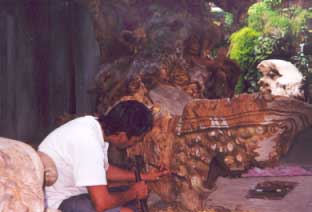 Performing in Bali was a surreal experience. In the states, we have so much control over the elements. We perform in an area that is separate from our world. We can manipulate lights, sound, and can set up an ambience that supports our vision. In Bali, life is art. A huge spider scrambling between our legs as we perform, the sound of a motor bike putting along in the middle of a performance, men gambling boisterously, dogs humping, people chattering...I had not anticipated this. What a life lesson! Life is art...art is life.
Performing in Bali was a surreal experience. In the states, we have so much control over the elements. We perform in an area that is separate from our world. We can manipulate lights, sound, and can set up an ambience that supports our vision. In Bali, life is art. A huge spider scrambling between our legs as we perform, the sound of a motor bike putting along in the middle of a performance, men gambling boisterously, dogs humping, people chattering...I had not anticipated this. What a life lesson! Life is art...art is life.
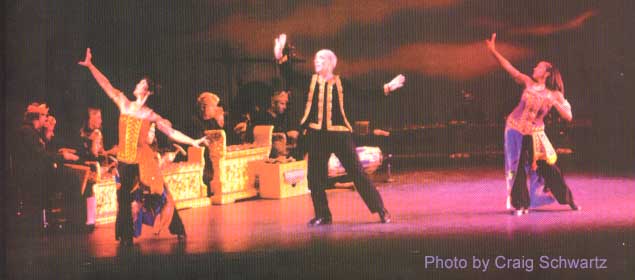
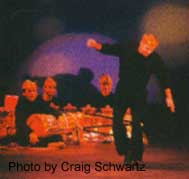
"Nusantara" brings together the lush, hypnotic sound of gamelan orchestra with the tinkling explosions of metal taps. Ethereal sensations...An aural feast...emphasizing the deliciously complicated, fine detailing possible in tap dancing.
The Orange County Register
